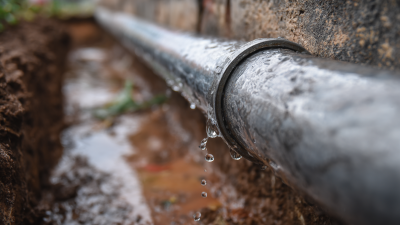As the world increasingly prioritizes sustainability and efficiency in construction and infrastructure projects, the geotextile non woven industry has experienced remarkable growth and innovation. According to a recent report by MarketsandMarkets, the global geotextile market is projected to reach $12.5 billion by 2025, with the non woven segment playing a pivotal role due to its versatility and performance in various applications such as erosion control, filtration, and soil stabilization. The implications of these advancements extend beyond economic metrics, as the industry adopts more environmentally friendly practices and materials to meet the demands of modern engineering challenges.

Expert insights from Dr. Emily Thornton, a noted geotextile specialist and author of "Advancements in Geosynthetic Technology", underscore the potential within this sector. She states, "The innovations in geotextile non woven fabrics are not just about enhancing strength and longevity; they are also about integrating smart technologies that can adapt to environmental conditions." This perspective highlights the transformative potential of smart geotextiles, which are poised to revolutionize applications such as drainage systems and geoengineering, thus further fueling market expansion.
As we delve into the top five innovations shaping the geotextile non woven industry, it becomes clear that 2025 is set to be a landmark year for advancements that promise to redefine the role of geotextiles in sustainable infrastructure development.
The geotextile non-woven industry is witnessing a transformation driven by emerging technologies that promise to enhance performance and sustainability. Innovations such as advanced fabric manufacturing techniques and eco-friendly materials are at the forefront. These technologies not only improve the mechanical properties of geotextiles but also contribute to environmental protection by utilizing recycled fibers and biodegradable components. As industries increasingly prioritize sustainability, these advancements align perfectly with global trends towards greener construction practices.
Furthermore, the incorporation of smart technologies into geotextile products is set to elevate their functionality. Smart geotextiles, embedded with sensors, enable real-time monitoring of soil conditions and structural integrity. This integration of IoT (Internet of Things) technology allows for proactive maintenance and optimized resource management, significantly reducing costs over time. As these innovations gain traction, they will catalyze substantial market growth, paving the way for the geotextile non-woven industry to flourish by 2025 and beyond, meeting the demands of an increasingly varied range of applications in civil engineering, environmental protection, and agricultural sectors.
This chart illustrates the projected growth in the geotextile non-woven industry from 2023 to 2025. The data reflects the increasing demand driven by emerging technologies and applications across various sectors.
The geotextile non-woven industry is experiencing unprecedented growth, driven by key market trends that are shaping its future. According to a recent report by MarketsandMarkets, the global geotextiles market is projected to reach USD 14.7 billion by 2025, growing at a CAGR of 7.4% from 2020. This growth can be attributed to increasing demand in infrastructure projects, erosion control, and environmental protection. As industries increasingly prioritize sustainability, non-woven geotextiles made from recycled materials are gaining traction, appealing not only to eco-conscious companies but also to regulatory bodies advocating for green materials in construction.
One notable trend is the rise of smart geotextiles featuring advanced functionalities such as moisture monitoring or temperature regulation. These innovations are particularly favorable in large-scale civil engineering projects, where enhanced durability and performance are crucial. For instance, a report from Technavio highlights that smart geotextiles have the potential to improve the lifespan of roadways and reduce maintenance costs by up to 25%.
Tips: When considering the use of geotextile non-woven materials, it's essential to evaluate the specific requirements of your project. Always look for products that comply with industry standards and offer data on performance metrics. Additionally, collaborating with suppliers who focus on innovation and sustainability can lead to more resilient and eco-friendly project outcomes.

In the rapidly evolving geotextile non-woven industry, sustainability practices are becoming a central focus for innovation. The growing demand for environmentally friendly materials has led manufacturers to adopt eco-conscious production processes. This includes using recycled materials in the fabrication of non-woven geotextiles, which not only reduces waste but also lowers the carbon footprint of the production cycle. These advancements are crucial as the industry seeks to minimize its environmental impact while meeting the needs of various applications, from road construction to land reclamation.

Furthermore, innovations in biopolymers and biodegradable geotextiles are gaining traction within the sector. These materials promise to maintain the functionality and durability of traditional geotextiles while offering a greener alternative. Companies are investing in research and development to enhance the performance of these sustainable options, ensuring they meet the rigorous demands of civil engineering and environmental projects. As the market for geotextile non-wovens expands, the integration of sustainability practices will play a pivotal role not only in compliance with regulatory standards but also in driving competitive advantage in a conscientious consumer landscape.
In 2025, the geotextile non-woven industry is set to witness significant developments driven by innovative strategies from major players. According to a recent report by Allied Market Research, the global geotextiles market is expected to reach $10.1 billion by 2025, growing at a CAGR of 12.5% from 2020. Key players such as Geosynthetics, Berry Global, and GSE Environmental are competing fiercely by enhancing their product offerings. Notably, Berry Global has introduced eco-friendly non-woven geotextiles made from recycled materials, further emphasizing sustainability in their production process.
Moreover, advancements in technology are playing a crucial role in reshaping competitive dynamics in the market. For example, TenCate Geosynthetics has developed a new line of non-woven geotextiles that utilize advanced needle-punching techniques, resulting in superior performance in soil stabilization applications. The adoption of such innovative manufacturing processes not only boosts operational efficiency but also improves the overall quality of products. As demand for erosion control, sedimentation, and filtration solutions rises across various sectors, these innovations position leading players to capture significant market shares while addressing environmental concerns.
The geotextile non-woven industry is experiencing transformative growth driven by various regulatory influences. Governments worldwide are implementing stricter environmental standards and sustainability practices, promoting the use of geotextiles for soil stabilization, erosion control, and drainage solutions in construction and civil engineering projects. These regulations not only encourage the adoption of eco-friendly materials but also create a platform for innovation, as manufacturers are pushed to develop advanced non-woven geotextiles that meet regulatory requirements while providing enhanced performance characteristics.
Moreover, compliance with international standards and certification processes has become integral to market growth strategies. Companies in the geotextile non-woven sector must navigate a complex landscape of regulations that vary by region, necessitating a strategic focus on product development and market entry. By aligning their innovations with regulatory trends, these companies can not only enhance their competitive advantage but also ensure long-term sustainability in a rapidly evolving market. As the industry looks toward 2025, effective navigation of these regulatory influences will be crucial for capturing growth opportunities and driving forward advancements in geotextile technology.
| Innovation Type | Description | Projected Market Growth (%) | Regulatory Influence | Market Strategy |
|---|---|---|---|---|
| Biodegradable Non Woven Fabrics | Innovative geotextiles made from biodegradable materials to reduce environmental impact. | 15 | Increased regulations on environmental sustainability. | Adoption of eco-friendly materials and processes. |
| High-Performance Geosynthetics | Developments in strength and durability for civil engineering applications. | 20 | Standards addressing safety and performance in construction. | Integration with advanced construction technologies. |
| Smart Geotextiles | Fabric that includes sensors for monitoring environmental conditions. | 25 | Emerging regulations on smart infrastructure. | Focus on IoT integration for smart city projects. |
| Reinforced Non Woven Geotextiles | Enhanced durability for erosion control and land stabilization. | 18 | Regulations on erosion and sediment control measures. | Targeting infrastructure projects in vulnerable areas. |
| Innovative Recycling Techniques | Using recycled materials to produce non woven geotextiles. | 22 | Policies promoting waste reduction and recycling. | Implementing circular economy principles. |






